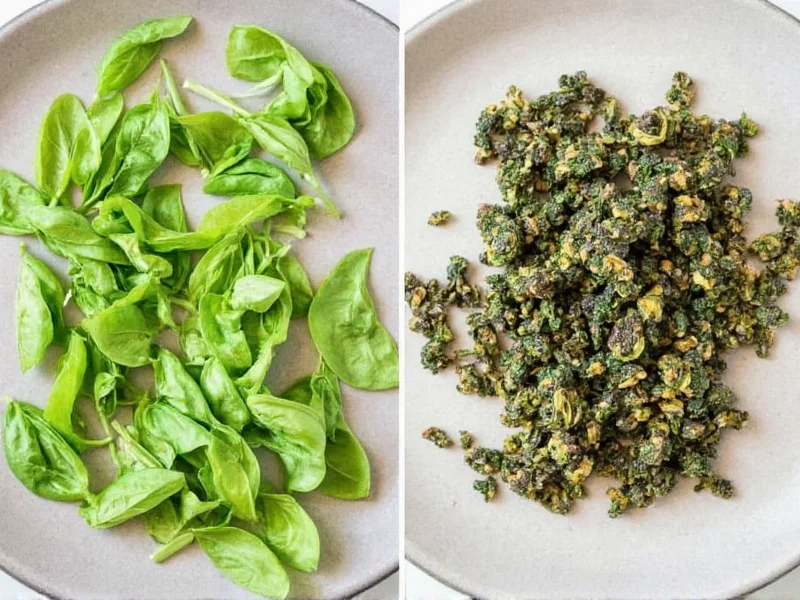The standard conversion ratio for fresh basil to dried basil is 3:1. This means you need three times the amount of fresh basil to equal the flavor intensity of dried basil. For example, 1 tablespoon of fresh basil equals approximately 1 teaspoon of dried basil. This conversion accounts for the concentration of flavors that occurs during the drying process, where moisture removal intensifies the herb's essential oils.
Understanding the proper conversion between fresh and dried basil prevents recipe failures and ensures balanced flavors in your cooking. Many home cooks make the mistake of using equal measurements, resulting in dishes that lack proper herb flavor or become overpowering. The 3:1 ratio serves as a reliable starting point for most culinary applications.
Why the 3:1 Conversion Ratio Works
When basil dries, it loses approximately 90% of its water content. This concentration process intensifies the essential oils and flavor compounds. Fresh basil contains volatile oils that provide its characteristic aroma, but these become more potent as moisture evaporates during drying. The 3:1 ratio compensates for this concentration effect, helping maintain recipe balance.
It's important to note that dried basil develops slightly different flavor notes compared to fresh. While fresh basil offers bright, sweet, and slightly peppery notes with hints of anise, dried basil develops earthier, more concentrated flavors with subtle mint undertones. This flavor transformation means the conversion isn't always perfectly linear across all recipes.
Practical Measurement Conversions
Refer to this conversion chart for common cooking measurements when substituting fresh basil with dried or vice versa:
| Fresh Basil | Dried Basil Equivalent | Common Recipe Application |
|---|---|---|
| 1 cup chopped | ⅓ cup | Pesto sauce, tomato sauces |
| ¼ cup | 1 tablespoon | Marinades, salad dressings |
| 2 tablespoons | 2 teaspoons | Stews, soups, braises |
| 1 tablespoon | 1 teaspoon | Finishing dishes, garnishes |
| 1 teaspoon | ¼ teaspoon | Delicate sauces, egg dishes |
Substitution Tips for Perfect Results
When substituting dried basil for fresh in recipes, consider these professional tips:
- Add dried basil earlier in the cooking process to allow time for rehydration and flavor release, while fresh basil typically goes in during the last few minutes of cooking
- Crush dried basil between your fingers before adding to release essential oils and improve flavor distribution
- Adjust to taste after initial conversion, as basil quality and drying methods affect potency
- Consider the dish type - dried basil works better in long-simmered sauces while fresh excels in raw applications like pesto
- Store dried basil properly in airtight containers away from light to maintain potency for accurate conversions
When Fresh and Dried Aren't Interchangeable
While the 3:1 conversion works for most cooked dishes, certain recipes don't translate well between fresh and dried basil. Traditional pesto requires fresh basil for its characteristic bright flavor and emulsion properties. Similarly, caprese salad depends on fresh basil's texture and visual appeal. For these dishes, no conversion ratio can adequately substitute dried basil.
Conversely, some long-cooked dishes like tomato-based pasta sauces, soups, and stews often benefit from dried basil's concentrated flavor that withstands extended cooking times. In these applications, the dried version may actually provide better flavor integration than fresh.
Storage Tips for Maximum Flavor Retention
Proper storage affects dried basil's potency and thus your conversion accuracy. Store dried basil in airtight containers away from heat, light, and moisture. Properly stored, dried basil maintains optimal flavor for 1-2 years. After this period, you may need to increase the amount slightly when substituting for fresh, as potency diminishes over time.
For the most accurate fresh basil to dried conversion measurements, check your dried basil's freshness by rubbing a small amount between your fingers. If the aroma is weak, you'll need to use slightly more than the standard ratio to achieve equivalent flavor.
Common Conversion Mistakes to Avoid
Many home cooks make these critical errors when converting between fresh and dried basil:
- Using equal measurements instead of the 3:1 ratio
- Adding dried basil at the same stage as fresh in recipes
- Not adjusting for the age and quality of dried herbs
- Substituting in recipes where texture matters (like garnishes)
- Measuring dried basil without breaking up clumps, leading to inconsistent amounts
Remember that the 3:1 conversion serves as a starting point. Always taste and adjust as you cook, as basil quality varies based on growing conditions, drying methods, and storage duration. Professional chefs often recommend starting with slightly less dried basil than the conversion suggests, then adjusting upward to prevent overpowering your dish.
Understanding Basil Varieties and Conversion
Different basil varieties behave slightly differently when converting between fresh and dried forms. Sweet basil (the most common variety) follows the standard 3:1 ratio. However, specialty varieties like Thai basil or lemon basil may require slight adjustments due to their unique oil compositions.
When working with less common basil varieties, start with the standard conversion ratio but be prepared to adjust based on taste. Some varieties lose distinctive flavor notes during drying, while others develop more pronounced characteristics. This knowledge helps achieve better results when substituting dried for fresh in specialty recipes.











 浙公网安备
33010002000092号
浙公网安备
33010002000092号 浙B2-20120091-4
浙B2-20120091-4